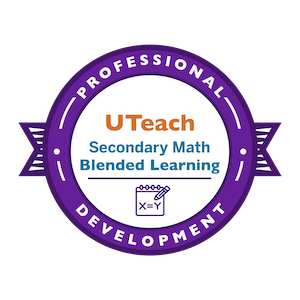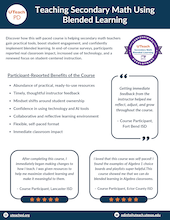12 weeks | 30 CPE credits
Asynchronous with opportunities for virtual collaboration
$1,200 per participant*

An additional perk! Free 90-day trial on IXL to explore mastery-based self-pacing.

Designed for secondary math educators aiming to cultivate student independence early, this course shares math-specific strategies to support success in any blended learning classroom. Participants experiment with various blended frameworks and adaptive online learning platforms that promote mastery-based self-pacing and personalized learning. By the end, educators will gain a holistic understanding of how to map out lessons with intentional technology integration that increases student engagement, achievement, and growth.
Fifth-grade teachers may also find this course useful.
*Course fees qualify for reimbursement by the Texas Education Agency upon completion.
Module 1 Blended Learning in a Secondary Math Classroom
This module provides an overview of the foundations of blended learning for teachers new to this pedagogical approach or serves as a review for those already familiar with the basic tools and strategies of blended learning. This overview includes secondary math-specific blended tools and strategies, complemented by video support and exemplars from Texas teachers who are already integrating blended learning in their secondary math classrooms.
Module 2 Backward Design for Planning Blended Instruction
This module will guide educators in organizing their course goals and exploring the Universal Design for Learning (UDL) approach to Backward Design. This method helps identify standards, plan assessments, and develop activities to effectively structure lessons aimed at achieving student mastery. Participants will apply Backward Design to map out a lesson and create an online formative assessment to evaluate student knowledge at the beginning of the lesson. The assessment will inform the teacher's planning of learning activities, ultimately promoting measurable student growth by the lesson's conclusion.
Module 3 Planning & Pacing
In this module, participants will review their Year-at-a-Glance planning document, examine examples of self-pacing in secondary math classrooms, and explore ways to incorporate self-pacing into their own multimodal, student-centered approach to secondary math instruction.
Module 4 Personalizing Secondary Math Using Blended Learning
This module focuses on familiarizing educators with instructional methods and online resources that promote student-centered learning, while also incorporating a data-driven approach. Teachers will create their own content using video-creation software and explore a choice of online adaptive programs to integrate into unit-level personalized pathways, enabling them to differentiate content and facilitate mastery-based self-pacing. Personalized pathways will include checkpoints that guide pacing based on data, as well as a progress tracking component.
Module 5 Inquiry, the 5Es, and Purposeful Technology in a Secondary Math Classroom
This module promotes the use of multimodal tools and strategies to encourage student exploration and inquiry. Teachers will explore and create job-embedded artifacts using the 5E framework to organize a mix of online and offline elements, leveraging adaptive online programs and online platforms to gamify practice and assessment with feedback, as well as platforms like Amplify Desmos Math and Geogebra that encourage students to learn through discovery. Students will investigate concepts using hands-on and virtual simulations to recognize patterns and make lasting connections. Teachers will incorporate student-led reflections, explanations, and collaborative learning opportunities within the 5E framework.
Module 6 Preparing Students for STAAR Success Without Teaching to the Test
This module asks participants to consider periodic assessments throughout the year, including continual formative assessments, unit summative assessments, SCAs, benchmarks, and the STAAR. Participants evaluate data from these assessments and develop student data trackers to support students in making data-guided choices in their review to help them achieve growth and, ultimately, mastery. This module provides examples of student tracking systems and highlights TEA STAAR resources to guide teachers in developing their own data-tracking approach, ensuring STAAR preparation is built into blended secondary math instruction. Secondary math teachers with non-tested preps will also explore data-tracking strategies to support data-driven instruction tailored to their unique classroom needs.
Module 7 Moving Forward with Blended Learning in Your Secondary Math Classroom
The final module asks participants to reflect on their explorations throughout the course and determine which blended learning frameworks and resources will best support their planning and implementation of secondary math instruction. Teachers will develop a comprehensive action plan outlining next steps for planning and implementing blended learning in their secondary math classrooms, as well as identifying future professional development and collaboration opportunities on their campus, within their district, offsite, or virtually.
Course Objectives
- Explore Blended frameworks to promote student-centered personalized instruction
- Understand and apply backward design to create job-embedded artifacts
- Utilize adaptive online programs and investigate materials to intentionally resource lessons and promote mastery-based and data-driven self-pacing
- Incorporate inquiry via the 5E framework with multimodal tools and strategies
- Review exemplars and progress tracking systems to guide student-led data-driven review for STAAR
- Create an action plan for a transition to blended learning



